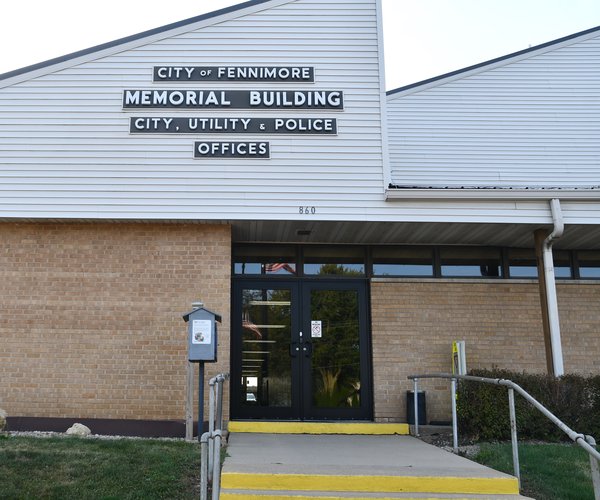With October designated as Manufacturing Month, CESA 3, Southwest Wisconsin Technical College, UW–Platteville, and the Southwest Wisconsin Alliance for Growth in Manufacturing hosted the 18th annual Business and Education Summit on the SWTC campus Wednesday.
The summit’s focus is to connect business, education, and economic development professionals to create partnerships that will result in collaborative solutions for the workforce needs of the present and the future in the manufacturing industry.
The keynote speaker for this year’s summit was Aaron Holverson, SWTC Cybersecurity instructor.
Holverson and three of his students explained how as the manufacturing industry moves along with automation, computers controlling moving parts, robotic arms and sensors, and with more companies interlinked, or collecting data from other companies, that cybersecurity has been become then more important than ever.
According to Holverson, 150 business operations were impacted by cyber attacks in 2022, from many different fields of industry such as auto, tire, food, publishing, and fuel just to name a few.
Holveson said hackers prey on people’s “human nature” to help, such as people receiving e-mails or texts that may look “legit,” but are in actuality a tool for hackers to infiltrate a company’s firewall, which in turn can also affect anny businesses that connect with the hacked system.
The Cyber Kill Chain, a step-by-step method hackers use to attack a system, was explained, and then Holverson’s students demonstrated how a hacked system is compromised once access is gain.
During a Q&A session after the presentation, Holverson noted how every company will experience some sort of hacking, no matter of their location (big city or small town) so prevention is of upmost importance.
He also said in his 23 years of teaching, every one of his students who graduates has been hired in the field.
Glen Brunner of Rockwell Automation, Jason Knapp of 3M, and Tiffany Lense of Sigma next went into detail about the recently started manufacturing alliance, the Southwest Wisconsin Alliance for Growth.
SWAG is based on a similar alliance, the Northeast Wisconsin Manufacturing Alliance, started in 2006.
SWAG members, like NEWMA members, came together mainly to “have their manufacturing voices heard,” as Knapp explained, as well as “work together to grow a pipeline of talent that will stay in the region.”
Lense said SWAG also aims to get away from the manufacturing stigma of “it’s all button pushing,” and that factories are just “dirty, dark place to work.”
Runner emphasized keeping jobs in region is more important than ever, saying that “industries grow communities.”
The three were then joined by fellow SWAG members Wesley Rowe from Cardinal IG, Tina Stoeffler from Truvant, and Theresa Sander from Biddick Inc., for a panel discussion led by Ron Brisbois, executive director of the Grant County Economic Development Corp.
A number of pre-written questions were answered by the panel, with some of the main points being that the employers today are looking more at prospective employees’ “soft skills,” such as listening, eye contact, self-management, problem-solving and teamwork.
Employee retention also came up in the panel’s discussion. Lense said keeping people happy is her company’s main concern, operating as “if jobs are not disposable, than people should not be as well.”
Brisbois shared Lense’s sentiment, saying, “even with companies moving more and more into automation, that human capital is the most important capital.”
Holly Straka, Workforce Innovation Grant coordinator at SWTC, said through the grant the college has been able to acquire $1 million in mobile training equipment for students, as well as having 50 training programs for 25 area manufactures such as the college’s recently started open weld nights.
Looking to the future, Straka said the college hope to expand its English Language Learning outreach, as well as add more specialized raining options for new and incumbent workers.
Jessica Helms, Cooperative Educational Service Agency District 3 Youth Apprenticeship coordinator, said CESA 3 continues to increase youth apprenticeships for high school juniors and seniors, which serves both area employers and students by “filling the gap of worker shortage, while learning careers.”
The summit’s focus is to connect business, education, and economic development professionals to create partnerships that will result in collaborative solutions for the workforce needs of the present and the future in the manufacturing industry.
The keynote speaker for this year’s summit was Aaron Holverson, SWTC Cybersecurity instructor.
Holverson and three of his students explained how as the manufacturing industry moves along with automation, computers controlling moving parts, robotic arms and sensors, and with more companies interlinked, or collecting data from other companies, that cybersecurity has been become then more important than ever.
According to Holverson, 150 business operations were impacted by cyber attacks in 2022, from many different fields of industry such as auto, tire, food, publishing, and fuel just to name a few.
Holveson said hackers prey on people’s “human nature” to help, such as people receiving e-mails or texts that may look “legit,” but are in actuality a tool for hackers to infiltrate a company’s firewall, which in turn can also affect anny businesses that connect with the hacked system.
The Cyber Kill Chain, a step-by-step method hackers use to attack a system, was explained, and then Holverson’s students demonstrated how a hacked system is compromised once access is gain.
During a Q&A session after the presentation, Holverson noted how every company will experience some sort of hacking, no matter of their location (big city or small town) so prevention is of upmost importance.
He also said in his 23 years of teaching, every one of his students who graduates has been hired in the field.
Glen Brunner of Rockwell Automation, Jason Knapp of 3M, and Tiffany Lense of Sigma next went into detail about the recently started manufacturing alliance, the Southwest Wisconsin Alliance for Growth.
SWAG is based on a similar alliance, the Northeast Wisconsin Manufacturing Alliance, started in 2006.
SWAG members, like NEWMA members, came together mainly to “have their manufacturing voices heard,” as Knapp explained, as well as “work together to grow a pipeline of talent that will stay in the region.”
Lense said SWAG also aims to get away from the manufacturing stigma of “it’s all button pushing,” and that factories are just “dirty, dark place to work.”
Runner emphasized keeping jobs in region is more important than ever, saying that “industries grow communities.”
The three were then joined by fellow SWAG members Wesley Rowe from Cardinal IG, Tina Stoeffler from Truvant, and Theresa Sander from Biddick Inc., for a panel discussion led by Ron Brisbois, executive director of the Grant County Economic Development Corp.
A number of pre-written questions were answered by the panel, with some of the main points being that the employers today are looking more at prospective employees’ “soft skills,” such as listening, eye contact, self-management, problem-solving and teamwork.
Employee retention also came up in the panel’s discussion. Lense said keeping people happy is her company’s main concern, operating as “if jobs are not disposable, than people should not be as well.”
Brisbois shared Lense’s sentiment, saying, “even with companies moving more and more into automation, that human capital is the most important capital.”
Holly Straka, Workforce Innovation Grant coordinator at SWTC, said through the grant the college has been able to acquire $1 million in mobile training equipment for students, as well as having 50 training programs for 25 area manufactures such as the college’s recently started open weld nights.
Looking to the future, Straka said the college hope to expand its English Language Learning outreach, as well as add more specialized raining options for new and incumbent workers.
Jessica Helms, Cooperative Educational Service Agency District 3 Youth Apprenticeship coordinator, said CESA 3 continues to increase youth apprenticeships for high school juniors and seniors, which serves both area employers and students by “filling the gap of worker shortage, while learning careers.”
Tom Martin, Career and Life Ready Coordinator at CESA 3, announced a partnership with Lab Midwest to open a pilot apprenticeship academy at River Valley High School in Spring Green, which will provide student skilled training by blending together IT, mechatronics, automation and manufacturing.





